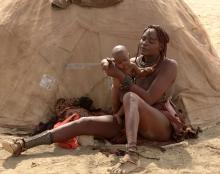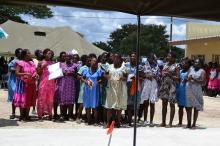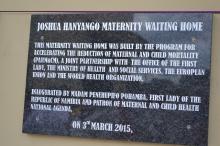Rural mothers in Namibia given access to quality maternal and newborn care
 The vast, forbidding landscapes of Namibia and the traditional nature of many of its tribal groups contribute to high rates of maternal and infant mortality. The country’s under-five mortality rate of 54 per 1000 live births is nearly twice the 2015 Millennium Development Goal (MDG) 4 target and the maternal mortality ratio of 385 per 100 000 live births is over six times and the MDG 5 target.
The vast, forbidding landscapes of Namibia and the traditional nature of many of its tribal groups contribute to high rates of maternal and infant mortality. The country’s under-five mortality rate of 54 per 1000 live births is nearly twice the 2015 Millennium Development Goal (MDG) 4 target and the maternal mortality ratio of 385 per 100 000 live births is over six times and the MDG 5 target.
Why are these rates so alarming, despite the fact that maternal health services are available in regional centres across the country? Data collection has shown that only 73% of births to women in the lowest wealth quintile were delivered by a skilled provider in contrast to 98% of births to women in the highest quintile. Also, it has been observed that only 80.3% of women living in rural areas delivered in a health facility in contrast to 94.7% of women living in urban areas. Therefore, a crucial factor is that 10% to 15% of deliveries in Namibia take place at home, without adequate and timely critical maternity care, predominantly in rural areas.
Without access to any public transport, impoverished pregnant women from rural communities must travel substantial distances, often over a 100 kilometres to reach the centres. Some set out, but have left too late, and give birth along the way. Others arrive when complications have set in, and it is too late to save the baby, or the mother. At these centres, it is commonplace for pregnant women to have to survive in the most rudimentary of shelters, while they wait a month, or two, for the onset of labour.
Many pregnant women, like Hambeleleni Jonas, chose to camp in an open field near to the Okongo Hospital, in Namibia’s Ohangwena Province. She said that hygiene in the camp was poor and conditions were really tough: “the women have no security against passers-by, and pigs roam freely through the camp. When it rains, they can’t cook.”
Addressing safety and providing an opportunity to access antenatal and maternity services and ensure children are properly immunized is recognised by the Namibian Government both through policy and action. The Programme for Accelerating the Reduction of Maternal and Child Mortality (PARMaCM) approaches maternal and infant health holistically, through integrated interventions.
One intervention by PARMaCM is providing the provision of decent, safe accommodation for expecting mothers through Maternity Waiting Homes. The first Maternity Waiting Home was completed in Okongo at the beginning of 2015. It was inaugurated by the former First Lady, Madame Penehupifo Pohamba, together with the Ministry of Health and Social Services (MoHSS), the European Union (EU) and the World Health Organization (WHO). The programme is funded until the end of 2017 by the EU, implemented by MoHSS and WHO. Until 2017 PARMaCM will have completed five (one with WHO’s own funding) Maternity Waiting Homes in total which will be managed by Regional Council and local constituencies.
“Women, particularly pregnant women and their newborns deserve the best. No woman should die giving birth, bringing life to this world and their newborns should survive. Society and the government need to be accountable for every death. We in WHO are very proud to be part of this initiative, making sure that every woman and newborn get the best they deserve,” said Dr Quazi Monirul Islam, World Health Organization Representative in Namibia.
The Maternity Waiting Homes themselves provide a safe environment for pregnant women where they can prepare for giving birth in hygienic conditions. Each Maternity Waiting Home will have dormitories, a kitchen, a dining hall and meeting area, showers and ablution facilities, and a laundry. They will also ensure that the women receive all the antenatal care they need, and are properly monitored, so that any problems can be addressed at once, and they can be taken to the maternity wards in good time.
The goal of improving maternity and newborn care is not limited to the Ohangwena Region. Times are particularly hard in the Otjisoko-Tjongava village north of the regional capital Opuwo. The region is home to the Himba people that are renowned for their striking appearance and dress, and smear their bodies in a mixture of ochre, butter fat and omumbiri – a sweet-smelling resin they collect from an endemic commiphora bush.
Mukanambinga Tjavara, an expecting Himba mother said falling pregnant for the first time was confusing for her. She noticed that her menstrual cycle had stopped, and she was vomiting a lot, but she did not yet understand what this meant. She confided in her mother, who realised that she was pregnant.
She went to Opuwo during her pregnancy, to check that the baby was well, and closer to the time, to give birth in the hospital. But this was not easy – in her village there are no cars, and they do not even have a donkey cart, so she had to ride on a donkey.
Now pregnant for a second time, Mukanambinga has been told of the planned Maternity Waiting Home in Opuwo in 2015. She said that this is an excellent idea – it will make things so much easier for women like her. She only hopes that it will be ready in time for her baby.
For more information, please contact:
WHO Namibia:
Ms Gesine Knolle, Communications and Advocacy Officer; Tel: +264 255 121; knolleg [at] who.int
WHO Regional Office for Africa:
Dr Cory Couillard, Communications Officer; Tel: + 472 413 9995; couillardc [at] who.int
___________________________________________
Below:
01. Young Himba mother in front of her self-made tent using sticks, cardboard and mosquito nets in Opuwo, Kunene Region
02. During the inauguration of the Okongo Maternity Waiting Home in Ohangwena Region, pregnant women sing and thank the former First Lady, Madame Penehupifo Pohamba for giving them a safe home whilst they are waiting for the delivery of their babies.
03. The first Maternity Waiting Home was inaugurated this year in Okongo in March. Two weeks later the Ground Breaking Ceremony was held in Omaheke Region for the second Home and two more are planned to be built until 2017 to benefit pregnant women and young mothers.





